You’ll achieve the richest dark roast profile between 225°C and 240°C (437°F-464°F), when your beans hit their second crack.
At these temperatures, the beans release vital oils and develop intense flavors through significant chemical transformations like the Maillard reaction and caramelization.
For best results, monitor your roast carefully after 220°C to capture complex notes without carbonization.
The perfect balance of heat and timing reveals your coffee’s deepest potential.
Key Takeaways
- The richest dark roast develops between 220°C to 250°C, with optimal flavor development occurring after the second crack at 225°C.
- French roast peaks at 240°C, creating intense, bold flavors before carbonization begins to compromise coffee quality.
- The critical temperature range of 225°C to 240°C locks in signature dark roast characteristics while maintaining flavor complexity.
- Monitoring temperature during the second roasting phase ensures deep flavors without crossing into burnt territory beyond 240°C.
- The Maillard reaction intensifies above 220°C, producing the rich caramelization and complex flavors characteristic of premium dark roasts.
The Science Behind Dark Roast Temperature Ranges
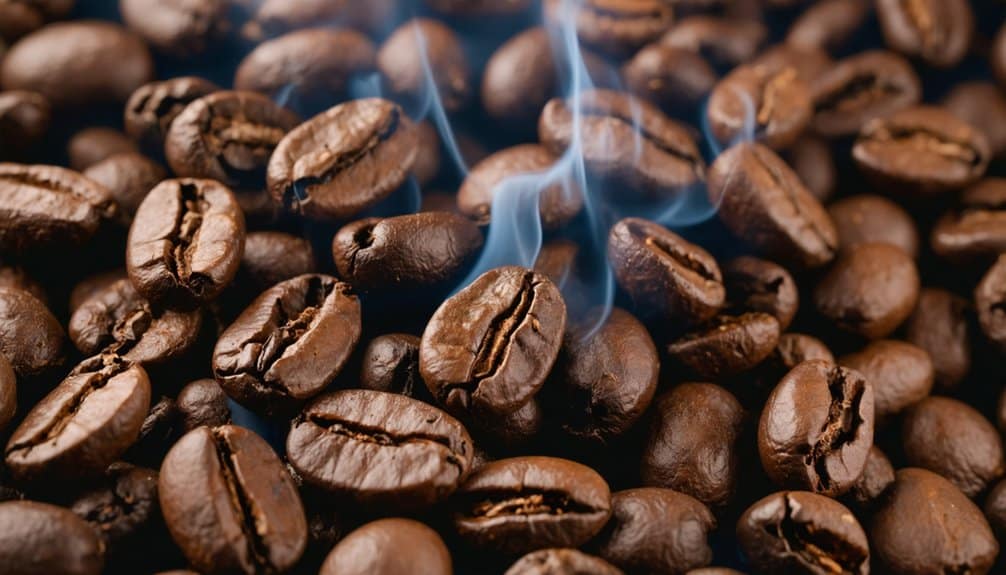
When aiming for the perfect dark roast, understanding the precise temperature ranges is crucial for achieving rich, complex flavors.
You’ll want to target temperatures between 220°C and 250°C, with key benchmarks at specific stages.
The second crack occurs around 225°C, signaling the beginning of dark roast territory. For classic dark roasts, you’ll find French roast peaks at 240°C, while Italian roast reaches 245°C.
Dark roasts should be brewed at lower temperatures to prevent excess bitterness. Watch for carbonization beyond 240°C, as it can compromise your coffee’s quality.
Remember, you’re looking for a high rate of rise into initial crack to develop those signature dark roast characteristics.
Optimal Heat Levels for Maximum Flavor Development
You’ll find the richest dark roast flavors emerge when you carefully control heat stages between 194-200°F throughout the brewing process.
Your attention to precise temperature control helps avoid the bitter notes that can develop when dark roasts are exposed to excessive heat.
By maintaining consistent temperatures within this ideal range and using an instant-read thermometer, you’ll enhance the smooth, complex flavor characteristics unique to dark roast coffee.
The cellular structure breakdown during dark roasting allows for easier flavor extraction at these lower brewing temperatures.
Heat Stages Matter Most
Understanding heat stages proves critical for revealing the richest flavors in dark roast coffee.
You’ll achieve ideal extraction between 190°F to 195°F (88°C to 90°C), where dark roast’s signature chocolate and caramel notes fully develop without bitter overtones.
You’re aiming for precision in every stage. During roasting, maintain temperatures above 220°C while avoiding carbonization.
When brewing, keep in mind that dark roasts are more sensitive to temperature than lighter profiles.
The extended roasting time creates an easily extractable structure that releases flavors readily.
You’ll want controlled extraction to preserve the coffee’s heavy body and low acidity.
The slower extraction at these specific temperatures guarantees you’ll capture the deep, complex flavors without unwanted compounds.
Timing Perfect Temperature Control
Three critical temperature stages define a perfectly timed dark roast. You’ll want to start preheating based on your batch size – 170°C for 400g, up to 200°C for 1kg.
Initial crack occurs around 200-202°C, marking your shift beyond light roasts. As you push toward 224-226°C, you’ll hit second crack, where rich dark roast characteristics develop.
The oil surface appearance indicates optimal dark roast development and signals complex flavor maturity.
For the richest flavor without bitterness, you’ll need to control your Rate of Rise carefully through these stages.
Keep your final roasting temperature between 225-245°C, and remember to cool quickly to lock in those deep, complex notes.
Temperature Control During Different Roasting Stages
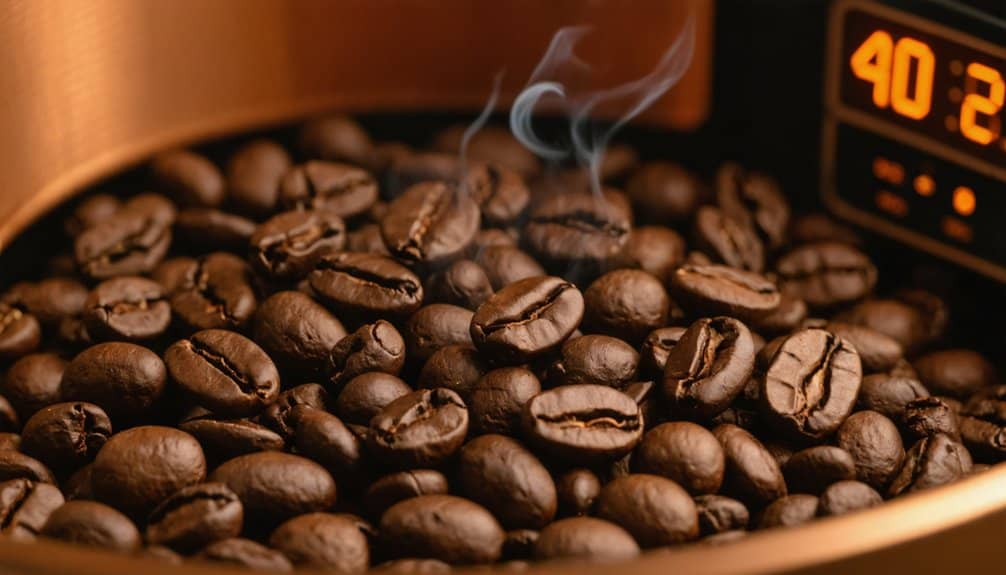
You’ll achieve the richest dark roast by carefully managing two distinct heating phases during the roasting process.
The initial phase requires a steady temperature rise from 180°C to 200°C, establishing the bean’s core development and moisture release.
The second phase, from 225°C to 240°C, locks in the intense flavors characteristic of dark roasts while preventing unwanted burnt notes.
During these phases, complex chemical reactions transform the beans through caramelization and create the signature smoky, chocolatey flavors.
First Heat Rising Phase
The critical primary heat rising phase begins immediately after the turning point, when bean temperatures shift from dropping to climbing.
You’ll want to maintain a steady, gentle rise to prevent “baked” coffee flavors from developing, while monitoring your Rate of Rise (RoR) carefully.
Modern roasting equipment makes this easier by capturing temperature data at regular intervals.
Your success during this phase depends on:
- Selecting the right preheat temperature for your batch size
- Managing your heat source, whether electric, gas, or wood-fired
- Controlling the RoR decline to prevent scorching
Watch for the maximum RoR after turning point, then guide your beans toward a steadily decreasing rate until Primary Crack.
Second Heat Flavor Lock
During critical flavor development, precise temperature control between 224-226°C (435-450°F) marks the decisive second crack phase where rich dark roast characteristics emerge.
You’ll notice your beans developing deeper caramel notes and a glossy surface as you maintain these temperatures.
Breaking cell walls occurs naturally during this phase, releasing oils to the surface.
To lock in the richest dark roast flavors, you’ll want to carefully monitor the progression through Full City (225°C), Vienna (230°C), and French Roast (240°C) stages.
Each degree affects your final cup profile, transforming acidity into body while enhancing those sought-after bittersweet notes.
Your attention to temperature control here prevents unwanted burnt flavors while maximizing complexity.
Impact of Heat on Coffee Bean Chemistry
Chemical transformations in coffee beans begin their complex dance at specific temperature thresholds, with the crucial Maillard reaction initiating around 150°C (302°F).
You’ll notice profound changes as heat transforms your beans through caramelization and pyrolysis.
The roasting process creates a symphony of reactions that’ll give you those rich dark roast flavors you’re seeking.
During roasting, beans transition from endothermic to exothermic at 165C.
- Darker roasts develop intense aromas through increased heat exposure
- Bitterness intensifies while acidity decreases at higher temperatures
- Exothermic reactions peak around 210°C, creating complex flavor compounds
Understanding these chemical changes lets you control your roast’s destiny, as temperature orchestrates the transformation from green to dark roasted beans.
Mastering Dark Roast Temperature Profiles
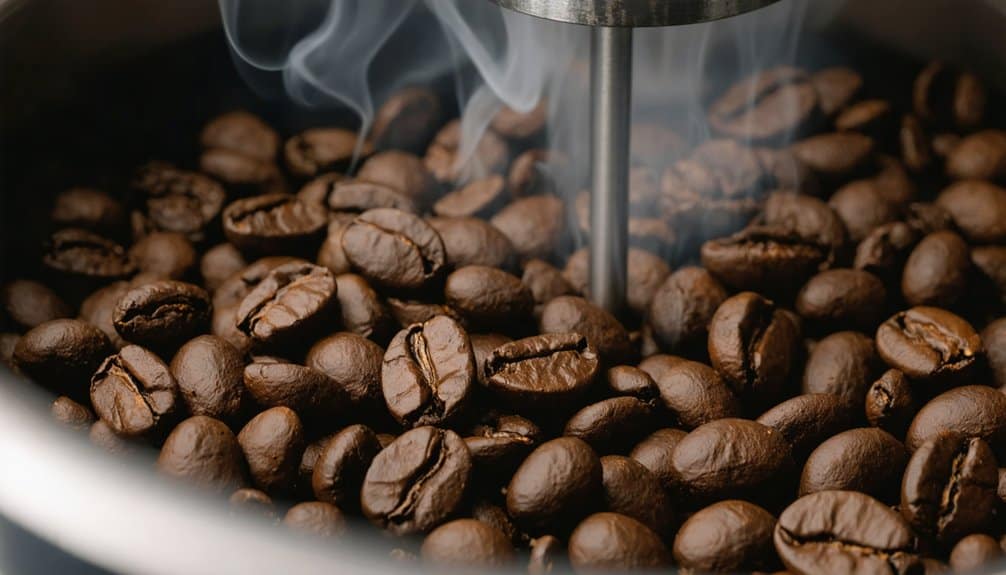
Mastering ideal temperatures for dark roast coffee requires precise control between 205-245°C (401-473°F), where each degree shift considerably impacts your final flavor profile.
You’ll find your sweet spot at 225°C for a Full City roast with its subtle oil sheen, or push to 230°C for a Vienna roast’s caramel notes.
For richer profiles, you’ve got two paths: hit higher temperatures briefly or maintain lower heat longer.
Starting with heat at 1:30 on the dial provides optimal control through the roasting phases.
Watch for initial crack around 200-202°C, then navigate to second crack at 224-226°C.
Your mastery comes from balancing time and temperature while adjusting heat to maintain steady development through these vital phases.
Key Temperature Points for Rich Dark Roasts
You’ll find that dark roast coffee achieves its richest flavors when brewed between 194°F and 200°F, with 195°F serving as an ideal starting point.
The roasting process itself requires careful attention to temperature thresholds, as excessive heat above 200°F can trigger unwanted bitterness while compromising the coffee’s natural sweetness.
Monitoring the development time post-first crack helps achieve optimal dark roast characteristics.
By maintaining precise temperature control during both roasting and brewing, you’ll extract the deep, smoky notes characteristic of premium dark roasts while preserving their complex flavor profiles.
Critical Heat Thresholds
Understanding the essential heat thresholds for dark roasting is vital for achieving the richest flavor profile in your coffee beans.
Your path to mastering dark roasts follows specific temperature milestones that transform your beans from light to luxuriously dark.
- Primary Crack occurs at 200°C, marking the initial release of complex flavors
- Second Crack emerges between 223-230°C, delivering deeper, bolder notes
- French and Italian roasts peak at 240-245°C, offering intense, smoky profiles
You’ll find ideal dark roast development between 220-240°C, where the beans develop their signature low acidity and full-bodied character.
Remember, precise temperature control prevents unwanted carbonization while maximizing rich, complex flavors.
Using a colorimeter for tracking can help ensure consistent results across your dark roast batches.
Roasting Time Sweet Spots
After establishing baseline heat thresholds, pinpointing the exact timing and temperature combinations becomes an art form in dark roast development.
You’ll find your sweet spot between 220°C and higher, with careful monitoring through primary crack (425-435°F) into second crack territory (440-450°F).
For the richest results, you’ll want to push beyond primary crack while maintaining a controlled rate of rise around 5°C per minute.
Your batch size influences the ideal temperature – 400g batches excel at 170-175°C starting points, while 700g batches of high-density beans can handle 200°C initial temperatures for peak development.
Careful monitoring of drum speed adjustments during larger batches ensures optimal heat transfer throughout the roasting process.
Equipment Considerations for Dark Roasting
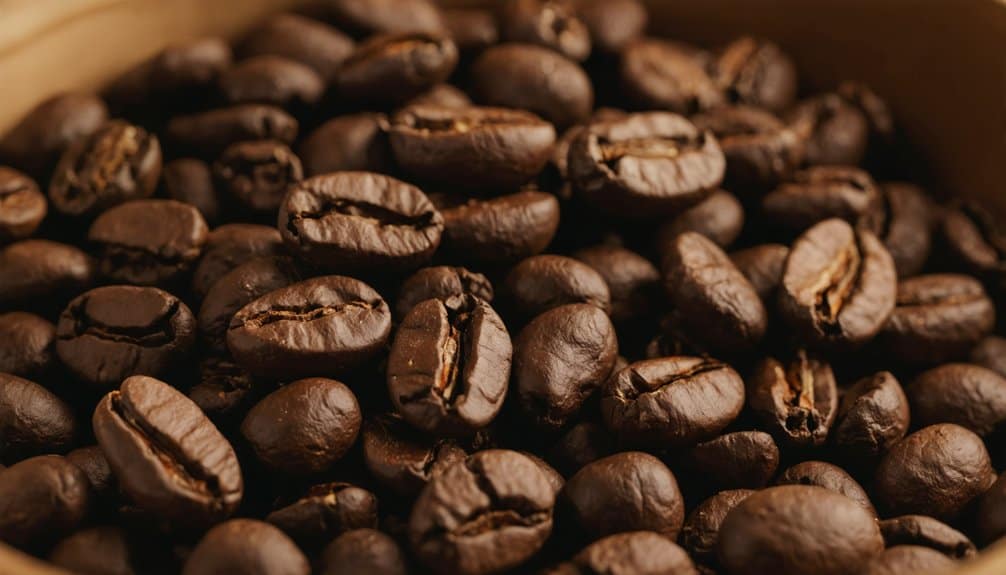
Several key roasting systems offer distinct approaches to achieving the ideal dark roast, each with its own advantages and control mechanisms.
Your choice of equipment heavily influences your ability to achieve rich, full-bodied dark roasts while avoiding common pitfalls like scorching or underdevelopment.
The three main stages of roasting – drying, caramelization, and development – must be carefully monitored with any equipment choice.
- Drum roasters excel with even heat distribution through both conductive and convective heating
- Fluidized bed roasters provide precise temperature control and uniform results
- Smart roasters like the IKAWA offer specialized settings for dark roast profiles
For best results, you’ll want to take into account batch size reductions and temperature monitoring capabilities.
Remember, each system requires specific techniques – from managing RoR post-First Crack to maintaining extended Maillard phases.
Monitoring and Adjusting Roast Temperatures
Precise temperature monitoring forms the cornerstone of achieving rich dark roasts, with ideal brewing ranges falling between 194°F (90°C) and 200°F (93°C).
You’ll want to maintain consistent temperature control throughout the process, as fluctuations can greatly impact your final cup’s flavor profile.
Keep a close eye on your roast progression by tracking the Maillard phase and development time after initial crack.
You’ll notice that adjusting your charge temperature and managing heat penetration will help you achieve more consistent results.
Keep in mind that environmental factors like humidity can affect your roast, so you’ll need to make real-time adjustments to maintain ideal temperatures.
Studies show that dark roast coffee generally contains lower concentrations of caffeine and chlorogenic acids compared to medium roasts.
Chemical Transformations at Peak Temperatures
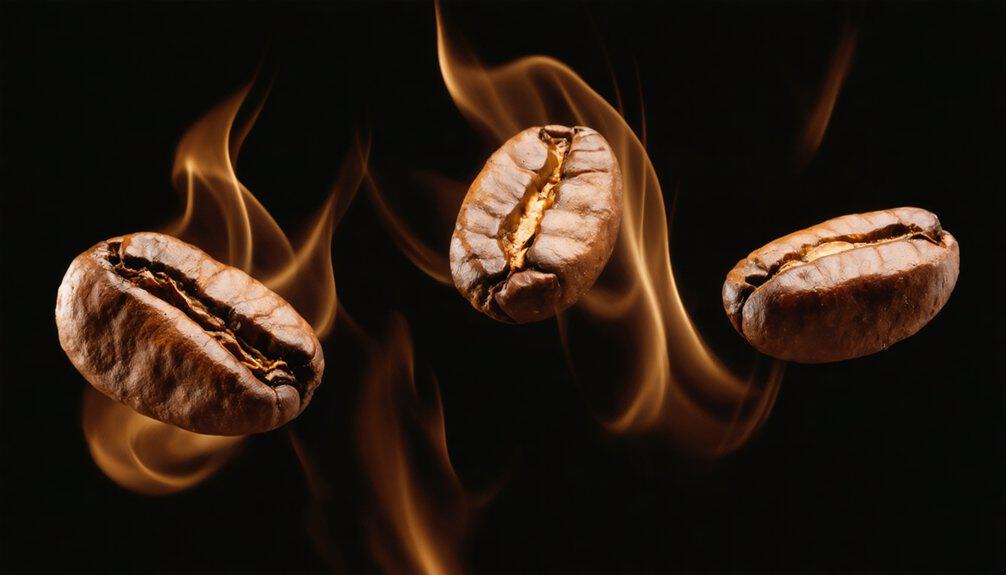
The rich complexity of dark roast coffee emerges through a series of chemical transformations that unfold at specific temperature thresholds.
As you push beyond 280°F, you’ll trigger the essential Maillard reaction, where amino acids and sugars create those deep, complex flavors you’re seeking.
Roast profiles determine the final flavor characteristics achieved through precise temperature control and timing.
- Caramelization intensifies after initial crack, breaking down sugars to develop rich, dark notes
- Chlorogenic acids decompose steadily, reducing brightness while enhancing bold character
- Strecker degradation produces distinctive aromatic compounds, contributing malty depth
These reactions work together at peak temperatures to create that satisfying dark roast profile you’ll recognize in every cup.
Best Practices for Dark Roast Temperature Control
Mastering temperature control stands as the cornerstone of achieving an exceptional dark roast, whether you’re brewing or roasting.
You’ll want to maintain precise temperatures throughout the process, focusing on both roasting and brewing parameters for ideal results.
Using a stick-type thermometer allows for consistent monitoring during the roasting process.
| Stage | Temperature Range | Key Consideration |
|---|---|---|
| Initial Roast | 220°C+ | Monitor Maillard reaction |
| Final Roast | 230-240°C | Watch for second crack |
| Cool Down | Rapid to 20°C | Prevent over-roasting |
| Grinding | Room temp | Maintain bean integrity |
| Brewing | 194-200°F | Avoid bitter extraction |
Remember to keep your brewing temperature lower than with lighter roasts to prevent unwanted bitterness and achieve that rich, complex flavor profile you’re seeking.
FAQs
Does Altitude Affect the Ideal Roasting Temperature for Dark Roasts?
Yes, you’ll need higher roasting temperatures at increased altitudes due to lower air density, requiring careful adjustment of your heat application to achieve consistent dark roast profiles.
How Long Should Beans Rest After Dark Roasting Before Brewing?
Like coffee beans exhaling after their intense roasting expedition, you’ll want to let your dark roast rest for 24-48 hours. This allows CO2 release and ideal flavor development before brewing.
Can Different Power Sources Impact Dark Roast Temperature Consistency?
You’ll find gas roasters provide quicker temperature adjustments for dark roasts, while electric roasters offer more stable, gradual heating. Both can achieve excellent results, but gas delivers superior consistency for large batches.
What’s the Best Container Material for Storing Freshly Roasted Dark Beans?
Cool as a cucumber, you’ll want dark glass containers for those fresh dark roasts. They’ll protect your beans from light damage while preventing flavor absorption and maintaining the rich complexity you love.
Does Bean Size Affect the Required Temperature for Achieving Dark Roast?
Yes, you’ll need to adjust temperatures based on bean size. Larger beans require higher temperatures and longer roasting times, while smaller beans need lower temperatures to avoid scorching their centers.
The Bottom Line
While you’ll hear some roasters claim there’s no perfect temperature for dark roasts, achieving the best flavor requires hitting 440-450°F (226-232°C) during second crack.
At these temperatures, you’ll enhance the complex Maillard reactions while avoiding the harsh, thin flavors that develop above 465°F.
Control your heat carefully through this critical phase to retain the rich, bittersweet notes that define exceptional dark roasts.
